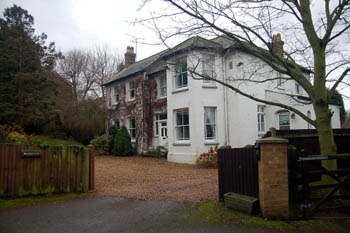Woodfield Aspley Guise

Woodfield - January 2008
Woodfield, on Weathercock Lane, first comes to our attention when it was put up for sale by auction in 1868 as part of the estate attached to the mansion on Aspley Hill - Woodlands House - owned by Richard Key.
The sale particulars [SF2/18/10] for Woodfield read as follows: "Compact Detached Villa Residence known as "WOODFIELD HOUSE", in the parish of Aspley Guise, situate facing the Road leading from Aspley to Woburn Sands Station, possessing an extensive Frontage thereto, and containing Entrance Porch, Dining Room, Drawing Room and Breakfast Room, Kitchen, Back Lobby, and large Scullery on the Ground Floor; excellent Cellar; and 4 airy Bedrooms, and Dressing Room, W. C., &c."
"In the Yard is a Pantiled Board and Stud Range of Buildings divided into Two Wood Barns, Workshop or Warehouse 28 feet by 17 feet 6 inches, and large Room over same size; 2-Stall Stable with Loft over; 2-bayed Cart Shed, together with the roomy Yard and fertile Garden, Soft Water Tank and Pump and Well of excellent Spring Water, the whole containing 2 roods 18 poles or thereabouts". Subsequent correspondence in SF2/18 makes it clear that the house and certain other lots in the same sale were not sold and the house appears to have remained in the Key family, but let to tenants.
Directories for Bedfordshire, published at regular intervals, but not annual, record the following occupiers:
- 1877, 1885 and 1890: Henry Down;
- 1894, 1898, 1903 and 1906: J. Wright Grant;
- 1910 and 1914: Robert Lewis Brander;
- 1920 and 1924: Ernest Muir Denham.
In 1927 this part of Bedfordshire was valued under the terms of the Rating Valuation Act 1925; every piece of land and property was inspected to determine the rates to be paid on it. The valuer visiting Woodfield noted [DV1/C/239] that it was owned by Miss M.A.Key but was vacant. The valuer described it as standing in just over half an acre, he also noted: "Been empty for some time". The building itself consisted of four reception rooms, a kitchen, scullery and wc downstairs, with a cellar below; on the first floor were six bedrooms, a dressing room, a bathroom and wc. Outside were a brick, timber and tile coach house with a loft over, stable and "sundry sheds".
By the late 1940s the owner was Blayney Key, who lived at Eel Pie Island, Twickenham [Middlesex]. In 1948 he appealed against the value put on the property in 1927. One of the reasons for his appeal was so extraordinary that it made local and national newspapers from Bristol to Dundee. The court did reduce the assessment due to the damaged and neglected condition of the house, but when Mr Key applied for a further reduction in 1949 his application was refused.